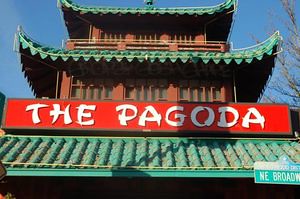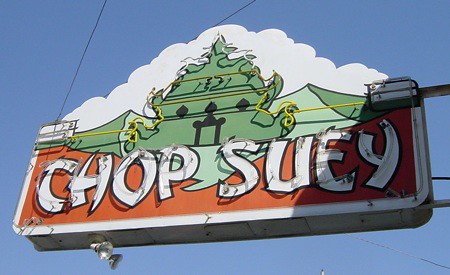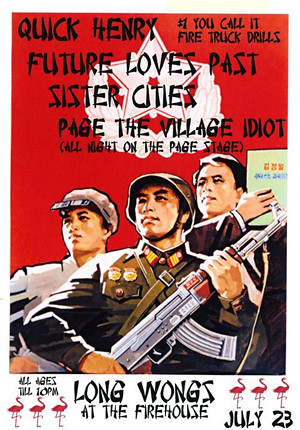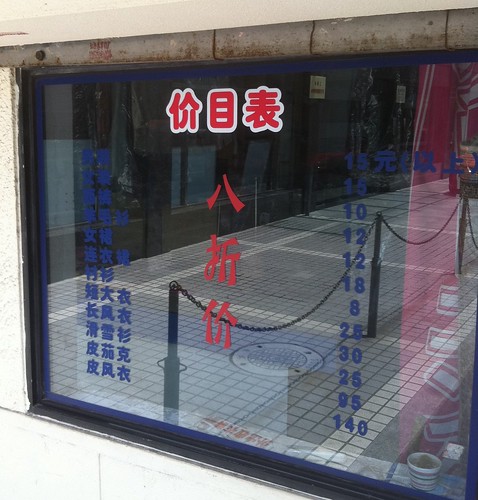The Rare Chinese Font
You know “the Chinese font“? The one that just screams Oriental, because it looks like it’s made out of bamboo pieces (?), mystically arranged by a wispy-bearded kung fu master?
In case you don’t know what I’m talking about, let me remind you:
Well, the above font is one that, in my experience, you’ll be hard-pressed to find in mainland China, especially in Chinese. (Anyone out there have a different experience?) Most typed Chinese here is in one of about 4 fonts, and “Oriental” isn’t one of them. This shouldn’t come as a surprise, I suppose; the Chinese just have no reason to parody themselves.
There’s a place on the way to the AllSet office in Shanghai that actually uses the “Oriental” font, though, in Chinese. This is a rare find. Here it is:
That’s a dry cleaner’s window. The “Oriental font” is in the middle. It says, 八折价, which means “80% of the original price.”
Mystical indeed.





So is the name of that font actually “oriental”? Is it available free online somewhere? Who knows when I might need to make my own dry cleaners sign.
I don’t actually know the name of the font. I gave it the “Oriental” name myself.
True — not much of that font here in China. But there are Chinese fonts that parody other languages, generally seen on/around Indian or Arab restaurants, which, of course, we also have in the West. I think all fonts that ape the writing of another culture are a little tacky, so I was somewhat saddened to see them here in China, but also secretly pleased: at least we’re not alone!
for example, http://bit.ly/mXNrBQ
Remember how the posters and DVD covers of 《可可西里/Hoh Xil: Mountain Patrol》 had 可可西里 written so that it was legible Chinese but resembled Tibetan script? I’ve seen a fair bit of that around.
so where did the font come from and why DOES it look like pieces of bamboo stitched together by some wispy-bearded kung fu master??
This visual stereotype reminds me of something in the musical realm that might be called “the Chinese melody”, which is a little ditty that gets played in TV or movie background music to evoke “Chinese-ness” (e.g., when a Fu Manchu-type character comes onto the scene). It’s a little pentatonic fragment that somehow early on became the stereotypic signature for “Chinese music”. For those who are musically literate, it’s the notes (in key of C for convenience) AAAA G G E E G, where the As are 16th notes and the rest are 8th notes. And where the melody is played with parallel fourths below. You can hear this in the cretinous 1970s pop hit “Kung-fu Fighting”, after the line “Everybody was kungfu fighting” (dee-dee-dee-dee dah-dah dah-dah daaah). But this meme also abounds in American TV and media culture.
Ah yes, the Chinese melody! I can actually play that… it’s so easy, because you can play it with just black keys and one fingering position.
There’s definitely a parallel here!
The “Chinese melody” is actually called the “Oriental riff” (or the “Asian riff”) and has its own Wikipedia article. And the Wikipedia article has a reference to a several-page article about the origin of that nine-note musical cliché.
“This shouldn’t come as a surprise, I suppose; the Chinese just have no reason to parody themselves”
Absolutley right…. The original font is supposed to make English look like Chinese ‘strokes’…. Once in a while (usually shopping mall signage, or Movie Posters) you see a Chinese font that’s trying so hard to look like English cursive script, it’s really impressive (and to a novice, barely recognizable as Chinese).
Oh, is that what it’s supposed to look like?? If that’s the goal, there have been some more recent attempts, using radicals and such, which do a much more convincing job.
You also have the ‘signature guys’ who for a fee will teach you how to sign your name so it looks like a signature in roman letters (I assume they teach it rather than just write it for you, since it is supposed to be your signature after all…) I’m always tempted to say ‘dudes, you are the heirs to a tradition which prized calligraphy above all other artforms and refined and developed it over millennia, and you want to write like my half-assed scrawl?’
…but on the other hand, it DOES look kind of cool I guess…
“the Chinese just have no reason to parody themselves”
I beg to differ! I think the Chinese people parody themselves all the time. Granted, most of our parodies of this kind are seen online, and most of them are in the form of political jokes, so not really a visual kind of parody…
Heh, true enough!
I guess I should be more specific. “The Chinese have no need to parody their own writing system from a Western perpective”?
The parodies (恶搞) the Chinese themselves do are actually specific aspects of Chinese culture or politics, based on a very informed view (rather than parodying their culture as a whole, based on ignorance).
We call it the “Chopstick” font here in California. It is usually on generic Chinese food to go restaurant signage.
Ah, the “Oriental riff”!! Here it is again, on a Stephen Colbert interview with John Huntsman at about 1:30.
http://gawker.com/5852997/jon-huntsman-defends-mormonism-speaks-mandarin-to-stephen-colbert